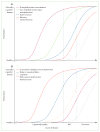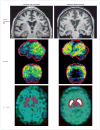Lewy body dementias
- PMID: 26595642
- PMCID: PMC5792067
- DOI: 10.1016/S0140-6736(15)00462-6
Lewy body dementias
Abstract
The broad importance of dementia is undisputed, with Alzheimer's disease justifiably getting the most attention. However, dementia with Lewy bodies and Parkinson's disease dementia, now called Lewy body dementias, are the second most common type of degenerative dementia in patients older than 65 years. Despite this, Lewy body dementias receive little attention and patients are often misdiagnosed, leading to less than ideal management. Over the past 10 years, considerable effort has gone into improving diagnostic accuracy by refining diagnostic criteria and using imaging and other biomarkers. Dementia with Lewy bodies and Parkinson's disease dementia share the same pathophysiology, and effective treatments will depend not only on successful treatment of symptoms but also on targeting the pathological mechanisms of disease, ideally before symptoms and clinical signs develop. We summarise the most pertinent progress from the past 10 years, outlining some of the challenges for the future, which will require refinement of diagnosis and clarification of the pathogenesis, leading to disease-modifying treatments.
Copyright © 2015 Elsevier Ltd. All rights reserved.
Conflict of interest statement
ZW has received personal fees from GE Healthcare, Bayer Healthcare, and Novartis; grants from GE Healthcare and Lundbeck; and her National Health Service employer received reimbursement for her time in connection to a phase 4 trial from GE Healthcare, outside the submitted work. KLP has received grants from the US National Institute on Ageing, Michael J Fox Foundation, Center for Medicare and Medicaid Innovation, and the Hellman Family Foundation; contract with Quest Diagnostics; and personal fees from Acupera. BFB has received grants from Cephalon, Allon Pharmaceuticals, FORUM Pharmaceuticals, GE Healthcare; and personal fees from Cambridge Medicine, the American Academy of Neurology, and Tau Consortium, all outside the submitted work. DA has received grants from GE Healthcare, and personal fees from Novartis and H Lundbeck, outside the submitted work.
Figures


References
-
- Emre M, Aarsland D, Brown R, et al. Clinical diagnostic criteria for dementia associated with Parkinson’s disease. Mov Disord. 2007;22:1689–707. - PubMed
-
- McKeith IG, Dickson DW, Lowe J, et al. the Consortium on DLB. Diagnosis and management of dementia with Lewy bodies: third report of the DLB Consortium. Neurology. 2005;65:1863–72. - PubMed
-
- American Psychiatric Association. Diagnostic and statistical manual of mental disorders DSM-5. 5. Washington, DC: American Psychiatric Association; 2013.
-
- McKeith I, Mintzer J, Aarsland D, et al. the International Psychogeriatric Association Expert Meeting on DLB. Dementia with Lewy bodies. Lancet Neurol. 2004;3:19–28. - PubMed
Publication types
MeSH terms
Substances
Supplementary concepts
Grants and funding
LinkOut - more resources
Full Text Sources
Other Literature Sources
Medical
Miscellaneous

